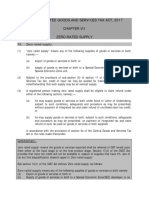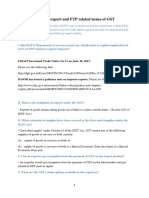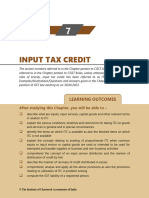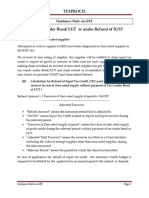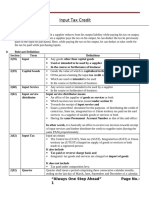GST and Exports: by Office of The Additional DGFT, Hyderabad
GST and Exports: by Office of The Additional DGFT, Hyderabad
Uploaded by
jahnavireddysathiCopyright:
Available Formats
GST and Exports: by Office of The Additional DGFT, Hyderabad
GST and Exports: by Office of The Additional DGFT, Hyderabad
Uploaded by
jahnavireddysathiOriginal Title
Copyright
Available Formats
Share this document
Did you find this document useful?
Is this content inappropriate?
Copyright:
Available Formats
GST and Exports: by Office of The Additional DGFT, Hyderabad
GST and Exports: by Office of The Additional DGFT, Hyderabad
Uploaded by
jahnavireddysathiCopyright:
Available Formats
GST AND EXPORTS
By
Office of the Additional DGFT, Hyderabad
Index
INTRODUCTION TO GST ................................................................................................. 2
IMPACT OF GST ON EXPORTS ...................................................................................... 3
Zero Rating of Exports: .................................................................................................. 4
Drawback/Refund .............................................................................................................. 7
Impact on MEIS and SEIS ................................................................................................. 8
SEZs ................................................................................................................................. 9
Supply of Goods to EOU (Purchase by EOU from DTA) .................................................. 10
Supply of Goods by EOU................................................................................................. 11
Supply from EOU to EOU ................................................................................................ 11
Tax Benefits for EOU under GST..................................................................................... 11
DEEMED EXPORTS ....................................................................................................... 12
ADVANCE AUTHORIZATION ......................................................................................... 13
EXPORT PROMOTION FOR CAPITAL GOODS............................................................. 14
IMPORTS AND IGST ................................................................................................... 15
GST & Exports Page 1
INTRODUCTION TO GST
GST is known as the Goods and Services Tax. It is an indirect tax which has
replaced many indirect taxes in India such as the excise duty, VAT, services tax, etc.
The Goods and Service Tax Act was passed in the Parliament on 29th March 2017
and it came into effect on 1st July 2017.
Goods and Services Tax Law in India is a comprehensive, multi-stage,
destination-based tax that is levied on every value addition. GST is a single
domestic indirect tax law for the entire country. Under the GST regime, the tax is
levied at every point of sale. In the case of intra-state sales, Central GST and State
GST are charged. All the inter-state sales are chargeable to the Integrated GST.
The advantage of having one single tax means every state follows the same
rate for a particular product or service. Tax compliance is also better as taxpayers
are not bogged down with multiple return forms and deadlines. Overall, it’s a unified
system of indirect tax compliance. GST has also helped in widening the tax base in
India.
One of the primary objectives of GST was to remove the cascading
effect of taxes. Under GST, the tax levy is only on the net value added at each
stage of the supply chain. This has contributed to the seamless flow of input tax
credits across both goods and services. Introducing GST has also led to an increase
in consumption and indirect tax revenues.
Due to GST being a nationwide tax and having a centralised surveillance
system, the clampdown on defaulters is quicker and far more efficient. Hence, GST
has curbed tax evasion and minimised tax fraud from taking place to a large extent.
GST & Exports Page 2
GST minimises transportation cycle times, improves supply chain and
turnaround time, and leads to warehouse consolidation, among other benefits. With
the e-way bill system under GST, the removal of interstate checkpoints is most
beneficial to the sector in improving transit and destination efficiency.
IMPACT OF GST ON EXPORTS
Exports are defined under Section 2(e) of the FTD&R Act, 1992. Export of goods, as
per this definition, refers to taking goods out of India by land, sea or air. Section 7 of
the act also mandates the use of an Importer-Exporter Code (IEC) for the purposes
of import and export. This IEC is issued by the DGFT.
The definition of “export of goods” in section 2(5) of IGST Act has been
straight taken from section 2(18) of the Customs Act, 1962 and means taking goods
out of India to a place outside India.
Importer-Exporter Code
For all IECs issued with effect from 1.07.2017, PAN number itself would be the IEC
number and would be authorised as IEC.
The GSTIN is the key identifier at the transaction level. The importer/exporter
needs to declare IEC and GSTIN (wherever registered with GST) at the time of
import/export of goods. The PAN level aggregation of data would automatically
happen in the system, thereby ensuring seamless integration of IEC data flowing to
Customs along with GSTIN.
GST & Exports Page 3
IEC generated Information forwarded Use IEC in ICEGATE for
by DGFT to ICEGATE (Customs) Export – Import
transactions
Old IECs linked to PAN All other information
while new IECs are linked to IEC through
same as PAN PAN data
Zero Rating of Exports:
The export of goods or services is considered as a zero-rated supply. GST will
not be levied on export of any kind of goods or services. The exporter has the option
either to export under bond/Letter of Undertaking without payment of tax and claim
refund of ITC or pay IGST by utilizing ITC or in cash at the time of export and claim
refund of IGST paid.
Zero rating means that the entire value chain of the supply is exempt
from tax. This is done by employing the following means:
• The taxes paid on the supplies which are zero rated are refunded
• The credit of inputs/ input services is allowed or is refunded in cases where
already paid
As per section 16 (1) of CGST Act, 2017 - “zero rated supply” means any of
the following supplies of goods or services or both, namely:
GST & Exports Page 4
A registered person making zero rated supply shall be eligible to claim refund
under either of the following options, namely:
• he may supply goods or services or both under bond or Letter of Undertaking,
subject to such conditions, safeguards and procedure as may be prescribed,
without payment of integrated tax and claim refund of unutilised ITC; or
• he may supply goods or services or both, subject to such conditions, safeguards
and procedure as may be prescribed, on payment of integrated tax and claim
refund of such tax paid on goods or services or both supplied,
Merchant Export
A merchant exporter is a person who is involved in trading activity and exporting or
intending to export. They do not have a manufacturing unit. They buy goods from a
manufacturer-exporter and then ship them to foreign customers.
Merchant exports are liable to GST as the merchant exporter is located in
India, and makes a supply to a place outside India. Thus, merchant exporters are
compulsorily required to obtain registration under GST.
Where a merchant exporter exports goods without payment of tax, procures
goods at 0.1% and then claims refund of the same :
The merchant exporter can claim a refund of the unutilised ITC at the end of a tax
period in case of zero-rated goods or goods involving an inverted tax structure.
GST & Exports Page 5
Where a supplier is supplying to a merchant exporter at a regular rate and
exports are done with the payment of IGST :
The standard tax regime will be followed by the supplier, where ITC shall be used for
payment of output tax and the balance liability is to be paid in cash. Merchant
exporters can claim a refund of both unutilised ITC and IGST paid against zero-rated
supply.
Where a supplier of a merchant exporter procures goods from another supplier
and claims refund under Inverted Duty Structure :
The second supplier can claim a refund of ITC under an inverted tax structure (rate
of tax on inputs is higher than the rate of tax on outputs). An illustration of Inverted
Duty Structure is given below.
GST & Exports Page 6
Drawback/Refund
A duty drawback was provided under the previous laws for the tax paid on inputs for
the export of exempted goods. Under GST, the duty drawback would only be
available for the customs duty paid on imported inputs or central excise paid on
certain petroleum or tobacco products used as inputs or fuel for captive power
generation.
An exporter dealing in zero-rated goods under GST can claim a refund for zero-rated
supplies as per the following options:
• Supply goods or services, or both, under bond or LUT; subject to such
conditions, safeguards and procedure as may be prescribed, without payment
of integrated tax, and then claim a refund of unutilised input tax credit.
• Any exporter or United Nations or Embassy or other agencies/bodies as
specified in section 55 who supplies goods or services, or both, after fulfilling
certain conditions, safeguards and procedures as may be prescribed; and
paying the IGST, can claim refund of such tax paid on the supplied goods or
services, or both.
GST & Exports Page 7
Impact on MEIS and SEIS
These scrips can be utilized only for
1. Payment of Basic Customs Duty and Additional Customs Duty specified
under sections 3(1), 3(3) and 3(5) of the Customs Tariff Act, 1975 for import
of inputs or goods, including capital goods, as per DoR Notification, except
items listed in Appendix 3A.
2. Payment of Central excise duties on domestic procurement of inputs or
goods
Further, Additional Customs duty specified under Sections 3(1), 3(3) and 3(5) of the
Customs Tariff Act, 1975 /Central excise duty paid in cash or through debit under
Duty Credit scrip shall be adjusted as CENVAT Credit or Duty Drawback as per
DoR rules or notifications. Basic Custom duty paid in cash or through debit under
Duty Credit scrip shall be adjusted for Duty Drawback as per DoR rules or
notifications.
The scrips cannot be used for payment of any type of GST-
IGST/CGST/SGST/UTGST or compensation cess.
GST & Exports Page 8
SEZs
A Special Economic Zone (SEZ) is a zone wherein businesses enjoy simpler tax and
easier legal difficulties. It is located in a country’s national borders only, but they are
treated as foreign territory for tax purpose.
In GST, SEZ will have Integrated Goods and Service Tax (IGST) as it will not
be considered as a part of India. Export means taking goods or services out of
Special Economic Zone by any mode of transport or supply of goods or service from
one unit in the SEZ to another unit in another SEZ. Import means bringing goods or
services into a Special Economic Zone by any mode of transport or receiving goods
or services from one unit by another unit located in another SEZ.
Being in a SEZ gives advantage as any supply of goods or services or both to
a Special Economic Zone unit or by developer will be considered as Zero Rated
Supply.
Supplies to SEZ are considered as exports, the supplier supplying goods to
SEZ can first supply under bond or he can make a letter of undertaking for making
supply of without payment of IGST and can also claim credit of ITC or he can supply
on payment of IGST and can claim refund.
When a SEZ unit or a developer supplies any goods or services or both to any
one, it will be also considered as integrated supply and will attract the Integrated
Goods and Service Tax (IGST).
There is only one exception to above rule. If an SEZ unit supplies goods or
service or both to Domestic Tariff Area (DTA), it will be considered as export to DTA
and custom duties and import duties will be payable.
The transporter has to carry the E-Way Bill of transportation of goods from
one place to another if the value is more than Rs. 50,000. The supply under SEZ is
treated as inter-state supply. The developer of Special Economic Zone shall have to
follow the same procedure of E-Way Bill as the other industry follows.
GST & Exports Page 9
EOUs
Export Oriented Unit (EOU) scheme was introduced in the year 1981. Under EOU
scheme, units registered as a EOU are required to export their entire production of
goods and services. However, certain portion is allowed to be sold out in domestic
tariff area (DTA).
The main objective of introduction of Export Oriented Unit scheme is to
increase exports, to increase foreign exchange earnings in the country and generate
additional employment.
Supply of Goods to EOU (Purchase by EOU from DTA)
Under GST, there is no exemption available to supplier of goods to EOU. IGST,
CGST and SGST, as applicable, will be payable by the supplier who supplies the
goods to EOU. EOU has two options to offset GST paid on goods received from
suppliers, the options are narrated below:
GST & Exports Page 10
• To take input tax credit of GST paid and utilizes the same towards supplies
made by EOU to DTA.
• Claim refund of GST paid.
It is always advisable to go for the first option. Option 2 is available only when there
are no enough DTA supplies against which input tax credit can be used.
Supply of Goods by EOU
When EOU units supply admissible goods to DTA units, EOU units are required to
pay applicable GST on such supply. Only in case of zero rated supplies, as defined
under section 16 of the IGST Act (namely export of goods and services, or, supply of
goods and services to SEZs), EOU are exempted from payment of GST.
Supply from EOU to EOU
When the goods are supplied by one EOU to another EOU, such supply would be
treated as any other supplies under GST law and hence GST would be payable on
the same as payable under any other supplies.
Tax Benefits for EOU under GST
The only benefit available to EOU unit is duty free import i.e. benefit of basic
customs duty exemption is available to EOU.
Further, exemption from the additional duties of customs, if any, under section
3(1), section 3(3) and section 3(5) of the Customs Tariff Act, 1975 and exemption
from central excise duty will be available for goods specified under the Fourth
Schedule to the Central Excise Act.
GST & Exports Page 11
DEEMED EXPORTS
As per the Foreign Trade Policy, Deemed Exports refer to those transactions in
which goods supplied do not leave the country, and payment is realized either in
Indian currency or free foreign exchange. The precise categories of deemed exports
are defined in Para 7.02 of the FTP.
“Deemed Exports” refers to supplies of goods manufactured in India (and not
services) which are notified as deemed exports under Section 147 of the
CGST/SGST Act, 2017. The supplies do not leave India. The payment for such
supplies is received either in Indian rupees or in convertible foreign exchange.
Deemed exports are not zero rated supplies by default, unlike the
regular exports. Hence all supplies notified as supply for deemed export will be
subject to levy of taxes i.e. such supplies can be made on payment of tax and
cannot be supplied under a Bond/LUT. However, the refund of tax paid on the
supply regarded as Deemed export is admissible to either the supplier or the
recipient. The application for refund has to be filed by the supplier or recipient
(subject to certain conditions) of deemed export supplies, as the case may be.
Categories of supply of goods notified as Deemed Exports as per para 7.02 of
FTP:
• Supply of goods by a registered person against Advance Authorisation
• Supply of capital goods by a registered person against Export Promotion
Capital Goods Authorisation
• Supply of goods by a registered person to Export Oriented Unit
(EOU/EHTP/STP)
• Supply of gold by a bank or Public Sector Undertaking specified in the
notification No. 50/2017-Customs, dated the 30th June, 2017 (as amended)
against Advance Authorization
GST & Exports Page 12
ADVANCE AUTHORIZATION
Advance Authorization is a scheme under the Foreign Trade Policy where the
import of inputs is allowed to be made duty-free (after making normal allowance for
wastage), if they are physically incorporated in a product which is going to be
exported. An export obligation is usually set as a condition for issuing Advance
Authorization.
Imports under Advance Authorization are exempted from payment of Basic
Customs Duty, Additional Customs Duty, Education Cess, Anti-dumping Duty,
Countervailing Duty, Safeguard Duty, Transition Product Specific Safeguard Duty
wherever applicable. Imports against Advance Authorizations are exempted from
Integrated Tax and Compensation Cess vide various DGFT notifications, the latest
one being DGFT Notification No. 16/2015-20 dated 01.07.2022.
DUTY FREE IMPORT AUTHORIZATION
Duty Free Import Authorization is issued to allow duty free import of inputs. In
addition, import of oil and catalyst which is consumed/ utilized in the process of
production of export product may also be allowed.
GST & Exports Page 13
Duty Free Import Authorization shall be exempted only from payment of Basic
Customs Duty (BCD).
EXPORT PROMOTION FOR CAPITAL GOODS
EPCG Scheme allows import of capital goods (except those specified in negative list
in Appendix 5 F) for pre-production, production and postproduction at zero customs
duty.
Capital goods for the purpose of the EPCG scheme shall include:
• Capital Goods as defined in Chapter 9 of FTP 2015-2020 including in
CKD/SKD condition thereof.
• Computer systems and software which are a part of the Capital Goods being
imported.
• Spares, moulds, dies, jigs, fixtures, tools & refractories.
• Catalysts for initial charge plus one subsequent charge.
• Import of capital goods for Project Imports notified by Central Board of Excise
and Customs is also permitted under EPCG Scheme.
Capital goods imported under EPCG Authorization for physical exports are
also exempt from IGST and Compensation Cess under the Notification No.
37/2022 – Customs dated 30th June 2022.
GST & Exports Page 14
IMPORTS AND IGST
The import of goods has been defined in the IGST Act, 2017 as bringing
goods into India from a place outside India. All imports shall be deemed as inter-
State supplies and accordingly integrated tax shall be levied in addition to the
applicable Custom duties.
The integrated tax on goods shall be in addition to the applicable Basic
Customs Duty (BCD) which is levied as per the Customs Tariff Act. In addition, GST
compensation cess may also be leviable on certain luxury and demerit goods under
the Goods and Services Tax (Compensation to States) Cess Act, 2017.
For imports made under Advance Authorization/EPCG schemes, the
corresponding components under the respective headers are waived off, in the bill of
entry. A sample scenario is presented below.
The taxes will be calculated as under:
Particulars Duty(Rs.)
A Assessable Value 100/-
B Basic Customs Duty@10% 10/-
C Education Cess @3% 0.3/-
D Value for Integrated Tax 110.30
E Integrated Tax @18% 19.85
F Value for Compensation 110.30
Cess
G Compensation Cess @ 15% 16.55
H Total Duty ( B+C +E+G) 46.70
In cases where imported goods are liable to Anti-Dumping Duty or Safeguard
Duty, value for calculation of IGST as well as Compensation Cess shall also include
Anti-Dumping Duty amount and Safeguard duty amount.
GST & Exports Page 15
Place of Supply
The place of supply of goods imported into India shall be the location of the importer.
Thus, if an importer say is located in Telangana, the SGST component of the IGST
paid at the time of import shall accrue to Telangana.
CUSTOMS BONDED WAREHOUSE
Supply of goods when the goods are still in Customs Bonded Warehouse: In
general, Customs Bonded warehouse is also treated as Customs Area. The customs
duty is charged only when the goods are ex-bonded i.e when the goods are removed
from the Customs bonded warehouse.
The integrated tax shall be levied and collected at the time of final clearance
of the customs-bonded warehoused goods for home consumption i.e., at the time of
filing the ex-bond bill of entry and the value addition accruing at each stage of supply
shall form part of the value on which the integrated tax would be payable at the time
of clearance of the warehoused goods for home consumption.
GST & Exports Page 16
HIGH SEA SALES
'High Sea Sales' is a common trade practice whereby the original importer sells the
goods to a third person before the goods are entered for customs clearance. After
the High sea sale of the goods, the Customs declarations i.e. Bill of Entry etc is filed
by the person who buys the goods from the original importer during the said sale.
IGST on high sea sale (s) transactions of imported goods, whether one or
multiple, shall be levied and collected only at the time of importation i.e. when the
import declarations are filed before the Customs authorities for the customs
clearance purposes for the first time. Further, value addition accruing in each such
high sea sale shall form part of the value on which IGST is collected at the time of
clearance.
GST & Exports Page 17
You might also like
- IStudio Singapore Iphone XS MAx PDFDocument1 pageIStudio Singapore Iphone XS MAx PDFسہیل خان100% (1)
- How to Handle Goods and Service Tax (GST)From EverandHow to Handle Goods and Service Tax (GST)Rating: 4.5 out of 5 stars4.5/5 (4)
- ExportDocument25 pagesExportBala VinayagamNo ratings yet
- Chapter12 - VII - PDF Zero Rated SupplyDocument3 pagesChapter12 - VII - PDF Zero Rated Supplyravi.pansuriya07No ratings yet
- Presentation 1Document23 pagesPresentation 1Adiba maazNo ratings yet
- Faqs On Export and FTP Related Issues of GSTDocument6 pagesFaqs On Export and FTP Related Issues of GSTJigar PunamiyaNo ratings yet
- Tybcom Tax Theory Sem 6Document4 pagesTybcom Tax Theory Sem 6y.zadaneNo ratings yet
- Chemexcil GST FAQsDocument230 pagesChemexcil GST FAQssrinivas100% (1)
- VAT Taxpayer Guide (Input Tax)Document54 pagesVAT Taxpayer Guide (Input Tax)NstrNo ratings yet
- Igst IntroductionsDocument4 pagesIgst IntroductionsBHUVANA THANGAMANINo ratings yet
- UntitledDocument9 pagesUntitledsuyash dugarNo ratings yet
- Chapter 5 Levy and Collection of GSTDocument59 pagesChapter 5 Levy and Collection of GSTMitanshi KhannaNo ratings yet
- Input Tax CreditDocument16 pagesInput Tax CreditPreeti SapkalNo ratings yet
- 6 ItcDocument114 pages6 ItcRAUNAQ SHARMANo ratings yet
- 76220bos61590 cp7Document208 pages76220bos61590 cp7Sunil KumarNo ratings yet
- Texprocil: Guidance Note On GSTDocument7 pagesTexprocil: Guidance Note On GSTChinmoy BaruahNo ratings yet
- Avana - Relevant Indirect TaxesDocument68 pagesAvana - Relevant Indirect TaxesVikas GuptaNo ratings yet
- Input Tax Credit ProjectDocument14 pagesInput Tax Credit Projectratna supriyaNo ratings yet
- Taxation IIIrd year-CGSTDocument7 pagesTaxation IIIrd year-CGSTsuraj shekhawatNo ratings yet
- Remaning TopicsDocument7 pagesRemaning TopicsAbhishekNo ratings yet
- HW 30873Document4 pagesHW 30873emritsaitama23No ratings yet
- UntitledDocument26 pagesUntitlediyaNo ratings yet
- 66519bos53752 cp6Document100 pages66519bos53752 cp6Aditya ThesiaNo ratings yet
- GST PPT 21 (34355)Document80 pagesGST PPT 21 (34355)Nickyta UpadhyayNo ratings yet
- EATG Unit 4-1Document32 pagesEATG Unit 4-1prashansa.yadav.1274No ratings yet
- How GST Can Impact Imports and Exports in India-Pankaj JHADocument2 pagesHow GST Can Impact Imports and Exports in India-Pankaj JHAjpauljha0% (1)
- Refunds Under GST: Chapter Thirty FourDocument21 pagesRefunds Under GST: Chapter Thirty FourRajNo ratings yet
- Types of Duty PDFDocument27 pagesTypes of Duty PDFfirastiNo ratings yet
- 67767bos54359 cp8 PDFDocument193 pages67767bos54359 cp8 PDFvenuNo ratings yet
- Unit 4 GST Liability and Input Tax CreditDocument20 pagesUnit 4 GST Liability and Input Tax CreditDelshin JoyNo ratings yet
- 62329bos50452 cp8Document186 pages62329bos50452 cp8Pabitra Kumar PrustyNo ratings yet
- 6mmmmm: M M M MDocument12 pages6mmmmm: M M M MUtsav PoddarNo ratings yet
- CUSTOMS LAW MANUAL - NotesDocument10 pagesCUSTOMS LAW MANUAL - NotesChetanya KapoorNo ratings yet
- TAXATIONDocument52 pagesTAXATIONjs787831No ratings yet
- Notes - Indirect TaxesDocument18 pagesNotes - Indirect TaxesSajan N ThomasNo ratings yet
- GST TheoryDocument24 pagesGST Theoryfintech.hodNo ratings yet
- LLB GST Notes-Unit-3-Part-2 - Final PDFDocument2 pagesLLB GST Notes-Unit-3-Part-2 - Final PDFravi kumarNo ratings yet
- Latest GST PPT DT 16 Apr 17Document29 pagesLatest GST PPT DT 16 Apr 17Venkatraman NatarajanNo ratings yet
- CUSTOMS DUTY - Module 3Document14 pagesCUSTOMS DUTY - Module 3Viraja GuruNo ratings yet
- GST Understanding Form GSTR 3BDocument10 pagesGST Understanding Form GSTR 3BAkhil SoodNo ratings yet
- Input Tax Credit-Cp8Document118 pagesInput Tax Credit-Cp8Shipra SonaliNo ratings yet
- Input Tax Credit Mechanism in GSTDocument9 pagesInput Tax Credit Mechanism in GSThanumanthaiahgowdaNo ratings yet
- CGST Full Form and CGST Meaning 3Document9 pagesCGST Full Form and CGST Meaning 3girirajNo ratings yet
- Export Promotion and Incentives: International Marketing Marzieh Arianfar Bims-University of Mysore APRIL 2013Document21 pagesExport Promotion and Incentives: International Marketing Marzieh Arianfar Bims-University of Mysore APRIL 2013Jai KeerthiNo ratings yet
- Drawback Section 75.Document4 pagesDrawback Section 75.PRATHAMESH MUNGEKARNo ratings yet
- Unit-1 GST (Continuation)Document70 pagesUnit-1 GST (Continuation)Anurag KandariNo ratings yet
- Input Tax Credit Under GSTDocument4 pagesInput Tax Credit Under GSTharshadaphandge165No ratings yet
- Indirect TaxesDocument6 pagesIndirect TaxesNikita JainNo ratings yet
- GST SoloniDocument14 pagesGST Solonisolonigarg4236No ratings yet
- Indirect Taxation (2) - RemovedDocument34 pagesIndirect Taxation (2) - Removedh74130384No ratings yet
- Hamza Tax Law 2Document18 pagesHamza Tax Law 2Ahmed ShujaNo ratings yet
- Service Tax Need For Service TaxDocument4 pagesService Tax Need For Service TaxAnonymous KJ1oUYCK8nNo ratings yet
- Notes On GST (Law of Taxation)Document15 pagesNotes On GST (Law of Taxation)Bhoomika SinghNo ratings yet
- GST - Input Tax CreditDocument14 pagesGST - Input Tax CreditvijayNo ratings yet
- Unit 3 GSTDocument51 pagesUnit 3 GSTMichael WellsNo ratings yet
- Value Added TaxDocument9 pagesValue Added TaxĴõ ĔĺNo ratings yet
- Latest Development in Indirect TaxDocument15 pagesLatest Development in Indirect TaxMuthuprakash.TNo ratings yet
- Import DutyDocument10 pagesImport DutyFuadNo ratings yet
- Input Tax CreditDocument19 pagesInput Tax CreditAnilBahugunaNo ratings yet
- How To ImportDocument30 pagesHow To ImportRiyaz ShaikhNo ratings yet
- Mod 5Document35 pagesMod 521bmsr0059No ratings yet
- List of Important Sections - GST May 2023 by CA Kishan KumarDocument5 pagesList of Important Sections - GST May 2023 by CA Kishan KumarNarayan choudharyNo ratings yet
- Tax Audit Clause 44 - FormatDocument8 pagesTax Audit Clause 44 - FormatAkshay TambeNo ratings yet
- AKIPG0472G - Show Cause Notice For Proceedings Us 143 (3) - 1047807373 (1) - 05122022Document16 pagesAKIPG0472G - Show Cause Notice For Proceedings Us 143 (3) - 1047807373 (1) - 05122022Aakash SinglaNo ratings yet
- Circular No 16 2023 - Refund-AbstactDocument14 pagesCircular No 16 2023 - Refund-AbstactsakthijackNo ratings yet
- @canotes Ipcc GST Question Bank PDFDocument208 pages@canotes Ipcc GST Question Bank PDFHindutav aryaNo ratings yet
- CGST LawDocument30 pagesCGST LawPranit Anil ChavanNo ratings yet
- Accounts and Finance Manager Curriculum Vitae (CV) Harun RashidDocument3 pagesAccounts and Finance Manager Curriculum Vitae (CV) Harun RashidHARUN RASHIDNo ratings yet
- Notice Pay - Amneal-Pharmaceuticals-Pvt.-Ltd.-GST-AAR-GujratDocument7 pagesNotice Pay - Amneal-Pharmaceuticals-Pvt.-Ltd.-GST-AAR-Gujratashim1No ratings yet
- Assignment IDocument6 pagesAssignment Imark assainNo ratings yet
- 2021 (March) : Attempt Questions QuestionsDocument19 pages2021 (March) : Attempt Questions Questionstreasurebts19No ratings yet
- Indirect Tax Laws: Final Course Study MaterialDocument17 pagesIndirect Tax Laws: Final Course Study MaterialoverclockthesunNo ratings yet
- This Report Was Prepared For Ray White Woollahra (388) - It Is A Breach of Before You Bid's Terms & Conditions To Hand Out This ReportDocument469 pagesThis Report Was Prepared For Ray White Woollahra (388) - It Is A Breach of Before You Bid's Terms & Conditions To Hand Out This ReportThomas MillerNo ratings yet
- Tally Prime 3.0 Webinar - 18bf4a4f f080 4ec4 9e9e 6111caa63d6bDocument44 pagesTally Prime 3.0 Webinar - 18bf4a4f f080 4ec4 9e9e 6111caa63d6bn8098654No ratings yet
- S1 2020 Reading Guide BTF3931Document13 pagesS1 2020 Reading Guide BTF3931Yu WeiNo ratings yet
- Pre Bid ClarificationsDocument22 pagesPre Bid Clarificationsprabhu kanthNo ratings yet
- GST in India - Everything We Need To Know - Taxguru - inDocument3 pagesGST in India - Everything We Need To Know - Taxguru - inChandrika RajaramNo ratings yet
- Taxation Full Test 1 May 2024 Test Paper 1707733583Document28 pagesTaxation Full Test 1 May 2024 Test Paper 1707733583Krish TejwaniNo ratings yet
- Commerce Syllabus FullDocument48 pagesCommerce Syllabus FullTapasNo ratings yet
- GST and BankingDocument8 pagesGST and BankingRudranil RoyNo ratings yet
- Impact of GST On Various SectorsDocument2 pagesImpact of GST On Various SectorsSwathi ReddyNo ratings yet
- 180712122508hazaribagh So OctoberDocument15 pages180712122508hazaribagh So Octoberjaio88No ratings yet
- Rera Rule 345Document58 pagesRera Rule 345Ankit SinghNo ratings yet
- A Project On Impact of GST On Various Construction ProjectsDocument99 pagesA Project On Impact of GST On Various Construction ProjectsFarooq KhanNo ratings yet
- RBI 2006 2008Pg180Document158 pagesRBI 2006 2008Pg180bheekhara100% (1)
- GST Survey Report - FinalDocument32 pagesGST Survey Report - FinalRoberto BelussiNo ratings yet
- Himachal Pradesh E-Mail/ Regd. Public Works Department: NO - SRJ/AB/PMGSY/HP-08-39A/2018-19-Dated: - ToDocument4 pagesHimachal Pradesh E-Mail/ Regd. Public Works Department: NO - SRJ/AB/PMGSY/HP-08-39A/2018-19-Dated: - ToKULDEEP SINGH THAKURNo ratings yet
- Writ Petition Challenging The Interpretation of Section 16 (AutoRecovered)Document10 pagesWrit Petition Challenging The Interpretation of Section 16 (AutoRecovered)noorensaba01No ratings yet
- GST Audit Vis A Vis Annual ReturnDocument30 pagesGST Audit Vis A Vis Annual ReturnchariNo ratings yet
- Annual Report 2015 IRDDocument164 pagesAnnual Report 2015 IRDhenfaNo ratings yet



